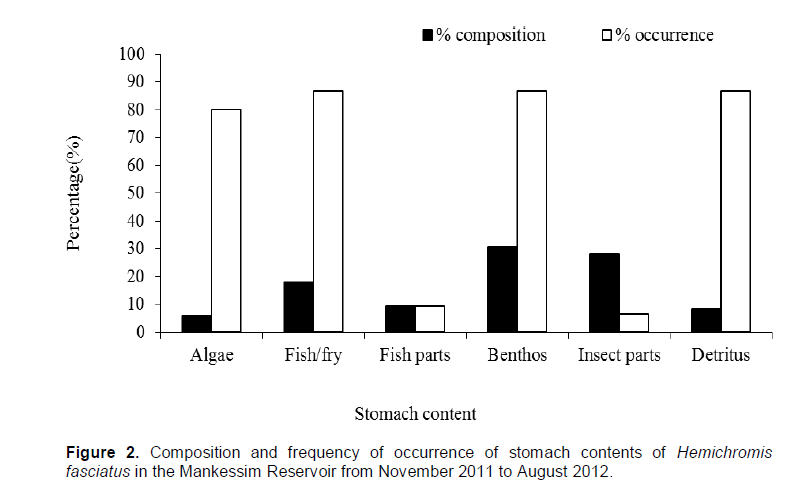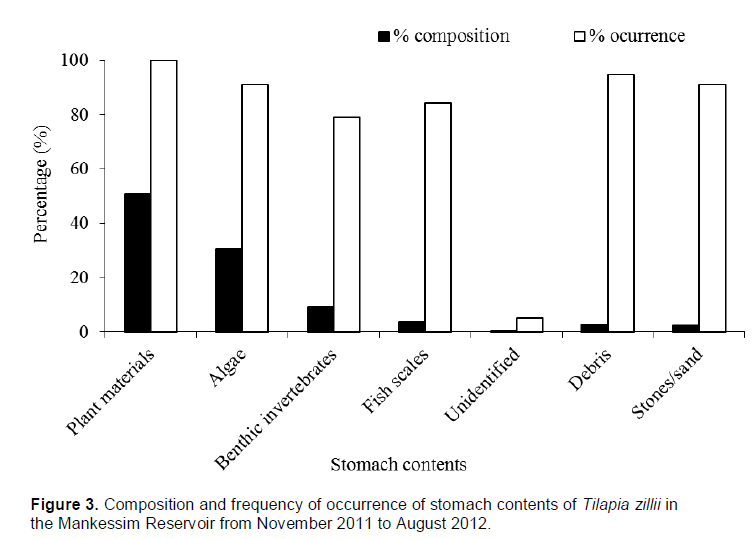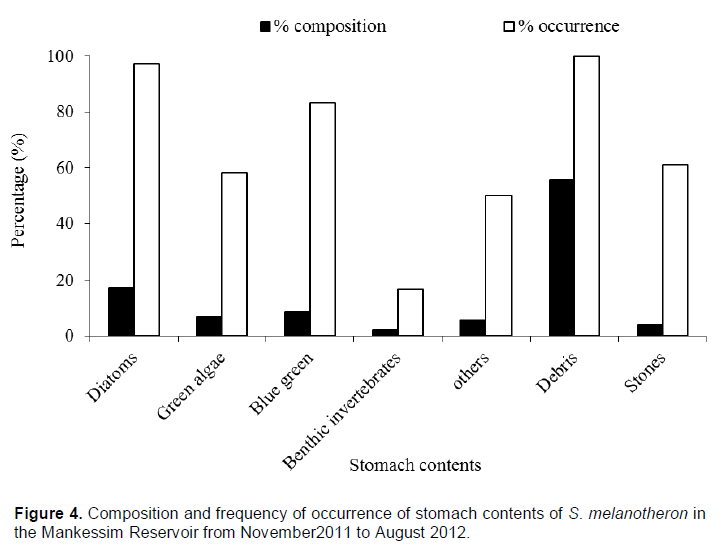ABSTRACT
The Mankessim Reservoir supports a thriving cichlid fishery that provides both financial gain and nutritional value to the people. Fish samples of Hemichromis fasciatus, Tilapia zillii and Sarotherodon melanotheron were obtained from artisanal fishermen by gill nets (10 m long and 1.5 m deep, 3, 6 and 12 mm mesh) and cast nets (25 mm mesh and 2.5 m radius) in the reservoir (5018''52.08'''N 1001''45.08'''W) from September 2011 to August 2012. Physicochemical parameters were measured in situ and nutrients level determined by the spectrophotometric method. Stomach contents were analyzed using the frequency of occurrence and “points” method and condition was evaluated by means of Fulton condition index. As a result, food resources exploited by T. zillii and S. melanotheron were highly similar. T. zillii fed more on plant material and benthic invertebrates with diatoms (Navicula spp., Pinnularia nobilis, Frustulia rohomboides, Stephanodiscus cymbella, Melosira spp., Gyrosigma spp., Tabellaria sp. and Diatoma sp.) blue green (mainly Ulothrix sp. Oscillatoria spp., Anabaena spp., and Microspora sp.) and desmids being the most preferred algae. S. melanotheron ingested more of debris, and fed on considerable amount of algae and benthic invertebrates mainly chironomid larvae and oligochaetes showing a high level of trophic flexibility. The three cichlids showed very good condition (1.75 ± 0.11 - 1.98 ± 0.40). This could probably be as a result of the observed favourable environmental conditions as all physicochemical parameters were within acceptable limits for their sustenance except for phosphates (1.68 ± 0.04 mg/L to 5.37 ± 0.02 mg/L).
Key words: Hemichromis fasciatus, Tilapia zillii, Sarotherodon melanotheron, Cichlids, Physicochemical parameters, Condition factor
There is an increasing interest in cichlids for aquaculture purposes. They are extensively cultured and perhaps the most economically important fishes of tropical African freshwater. For all these reasons, the knowledge on their biology is really important (Soyinka et al., 2013). According to Abowei et al. (2009), the wellbeing of fish is partly determined by the food they exploit and other environmental factors.
A study of the stomach contents can be used to determine its food habits. And this knowledge on food habits could further serve as basis for the development of successful capture and culture fisheries world-wide (Blay and Eyeson, 1982). Ndome and Victor (2002) emphasized that information on the feeding ecology of fish species is a prerequisite to the use of the fish for culture, exploitation and rationale management. Alot of studies have been done in other systems (Ugwumba, 1988; Ugwumba and Adebesi, 1992; Atindana et al., 2014) but little documented work has been carried out in the Mankessim Reservoir.
The three species have over the years grown and survived well to big sizes as compared to their counterparts from surrounding water bodies. This study is aimed at documenting reliable scientific data on their food habits and general wellbeing and possibly highlight reasons for their distinctly thriving ability in the water required for their culture while offering some clues into fisheries policy and regulations.
Study area
Mankessim Reservoir is situated about 30 km North – East of Cape Coast in the Central Region of Ghana and lies on latitude 5Ëš18''N and longitude 1Ëš01''W (Figure 1). The study was conducted first week of every month from September 2011 to August 2012 between 6:00 GMT and 9:00 GMT.
Measurement of environmental factors
Nutrient levels were measured using a HACH D2800 spectrophotometer by employing the Cadmium Reduction Method for determining nitrates and Molybdovonadate Method for phosphates (APHA, 1998).
Fish sampling and data collection
A minimum of 30 specimens comprising both males and females for each of the species were collected each month from artisanal fishermen. Standard length measurements were taken using a measuring board to the nearest 0.01 cm and the weight estimated to the nearest 0.01 g using an electronic scale and hand held balance (for heavier fish).The guts of the fish were removed, weighed (to the nearest 0.01 g) and preserved in 10% formalin. Stomachs of specimens were removed and contents of stomachs were examined under a microscope.
Physicochemical parameters
Monthly means of the physicochemical parameters for the period were calculated using Minitab (Version 15) and statistically tested for any differences using a paired student’s t - test (Zar, 1999).
Analysis of data on fish species
Condition factor (K) of the experimental fish was estimated from the relationship:
K= 100W/L3(Fulton’s index)
Where K = condition factor (CF)W = weight of fish (g); L = Length of fish (cm).The value of the condition factor is around 1 (no unit) the closer the value is to 1 implies very good, the farther it is away from 1or closer to 0 is poor.
Stomach contents were analyzed using the frequency of occurrence and “points” method (Bagenal, 1978; Hyslop, 1980; Lima and Goitein, 2001). The frequency of occurrence method estimates the percentage of stomachs in a sample containing a given food item whereas the “points” method gives the bulk contribution of each food item to the total food consumed. Points were awarded to each stomach according to its degree of fullness; 10 points for full stomach, 5 for half stomach and 2.5 for quarter filled stomach. Empty stomachs were excluded from the analysis. The total number of points awarded to each stomach was subdivided among the food items present according to their relative contribution to the total stomach content. The percentage composition of each of the food items was determined by summing up the points awarded to the item and dividing it by the total points awarded to all stomachs containing food, and the resulting value expressed as a percentage.
Physicochemical parameters
All water parameters were within acceptable ranges for sustenance of aquatic life (WHO, 1993) except for phosphates (Table 1).
Food habits of the cichlids
The percentage frequency of occurrence and composition of the various food items consumed by Hemichromis fasciatus, Tilapia zillii and Sarotherodon melanotheron are illustrated in Figures 2, 3 and 4, respectively.



Hemichromis fasciatus
Of the 325 stomachs examined, 96 stomachs representing 29.54% contained food. Algae, fish/fry, fish parts, benthic invertebrates, blue green algae and desmids were also frequently found in the stomach of the fish. The species preyed more on benthos and fish fry which constituted greater than 30% of the total food consumed and occurred in not less than 80% of all the stomachs examined. It preferred benthic invertebrate species such as the Chaoborus sp., chironomid and caddis fly larvae. Insect parts, fish fry and detritus formed less than 15% composition and occurred in not more than 85% of the stomachs.
Tilapia zillii
Of the 78 stomachs containing food, plant Material, material, debris, sand grains and algae were the main contents (Figure 3). Plant material and algae constituted 30% and occurred in greater than 70% of the food
eaten.
Algae constituted 30.68%, benthic invertebrates 9.32%, fish scales 3.65 %, debris 2.66%, and stones/sand 2.43 % of the stomach contents and all occurred in more than 5.26 % of the food ingested. Diatoms in the stomachs of T. zillii were mainly Navicula spp., Pinnularia nobilis, Frustulia rohomboides, Stephanodiscus cymbella, Melosira spp., Gyrosigma spp., Tabellaria sp.and Diatoma
sp.
The blue green algae were made up of Ulothrixsp.Oscillatoria spp., Nostoc sp., Anabaena spp., Eucapsis sp., Spirulina sp. and Polycystis sp. Microspora sp. was the filamentous form
encountered.
The desmids encountered were Closterium spp., Cosmarium spp., Gonatozygon mougeotia, Pleurutaenium trochistum, Staurastrum sp., Micrasterias sp., Protococcus sp. and Pediastrum spp. Benthic invertebrate organisms like chironomids (Chironomus sp. and Nilodorum sp.),
Chaoborus sp., caddisfly larvae (Setodes sp.) coleopteran and hemipteran larvae and some crustaceans were found in the stomachs of some specimens.
Sarotherodon melanotheron
The stomach contents of 114 specimens measuring 10 to 22.7 cm standard length, and weighing 47.36 - 500 g were examined. As shown in Figure 4, in terms of composition debris, diatoms and blue green algae were the most important items ingested by the fish followed by green algae, others, stones and benthic invertebrates accounting for 55.65, 17.22, 8.52, 6.87, 5.74, 3.74 and 2.26% of the stomach examined. Similarly, in terms of occurrence all items occurred in more than 20 % of the food eaten. Synedra sp., Tabellaria spp., Diatoma spp., Melosira spp. were the main diatoms eaten on by the fish.
Spirulina spp. was commonly found than the other blue green algae like Oscillatoria spp., Microcystis sp., Microspora sp., Protococcus sp. and Zygnaema sp. The green algae found were mostly filamentous types such as Spirogyra sp. and the desmids Micrasterias fimbriata, Closterium spp, Cosmarium spp., Pediastrum spp., Gonatozygon spp. and Tetrame bresbissonii.
Condition factor of the three species
All three species were found to be in very good condition (Table 2).
All water parameters were within acceptable ranges for sustenance of aquatic life except phosphates (WHO, 1993). Generally the reservoir showed higher concentrations of phosphate than nitrate with overall mean concentration of nitrate and phosphate ranging from 0.38 to 0.49 mg/L and 1.68 mg/L to 5.37 mg/L respectively. With the exception of nitrate which was found to be within the acceptable range for lentic ecosystems (0.003 to 7.00 mg/L), phosphate was above the recommended level (<0.05 mg/L) (Wetzel, 2001).Through personal observations and interviews with some farmers, the higher levels of phosphate compounds could be attributed to the use of a high phosphate containing fertilizer (Root developer) with Nitrogen, Phosphorous and Potassium (N P K) ratio of 10: 50: 10 in vegetable farms along the banks of the reservoir. This result corroborates the observation of Antwi and Ofori-Danson (1993), who observed the existence of nearby agricultural farms as responsible for the increase in nutrients in reservoirs.
Food habits
The well-being of fish could be determined partly by the quality and quantity of food it eats. According to Bagenal (1978) the maximum size that a fish can reach may possibly be affected by the various food resources and their availability in its environment. In comparison with a previous study on the reservoir by Avortri (1989) there was similarity in observations made on food items eaten by each of the three cichlids except for S. melanotheron. The diet of H. fasciatus in this study however revealed a wide spectrum than populations in the Golinga Reservoir in Ghana (Atindana et al., 2014). Insect parts and benthic invertebrate species such as coleopterans, chironomids, Chaoborus sp. and caddis fly larvae were the other stomach contents from specimens in the Mankessim Reservoir. Such a relatively wide variation in food exploited by the two populations, suggests the availability of these food items in the Mankessim Reservoir. This could be due to high nutrient levels in the water triggering the abundant growth of algae and other primary producers required for the sustenance of the aquatic food chain. Also, the findings of Dankwa et al. (1999) suggests the species is a minor piscivore which is similar to this study due to the range of dietary prey consumed by the species.
There was a high similarity in food resources exploited by T. zillii and S. melanotheron. Both species showed a high level of trophic flexibility in that T. zillii fed more on plant material and benthic invertebrates (mainly Chaoborus sp., caddisfly larvae, coleopteran and hemipteran larvae) with diatoms, blue green and desmids being the algae preferred. Conversely, S. melanotheron ingested more of debris, considerable amount of algae and benthic invertebrates mainly chironomid larvae and oligochaetes. This might be a means of minimizing interspecific competition and ensuring their coexistence. Considering the observed food habits of the three dominant species in the reservoir, H. fasciatus can be classified as an invertevore – piscivore and the tilapia species: T. zillii and S. melanotheron microherbivore – detritivore according to the trophic guilds used in Wooton (1998) and Esteves et al. (2008). Condition factor has been used as an index of growth and feeding intensity and influences the reproductive cycle in fish. The high condition index of the species during the study is possibly due to the availability of their food resources and favourable environmental conditions in the reservoir.
CONCLUSION AND RECOMMENDATION
The broad spectrum of food items eaten by the species and their preference for different food items could be strategies adopted to avoid interspecific competition and ensure their coexistence. The observed environmental conditions of the water could be possible reasons for the thriving abilities of the cichlids. However considering the high levels of phosphates in the water which is an indication of some level of pollution, it is important for farmers to farm away from the banks of the system to help prevent future deterioration of the quality of water and sustain aquatic life.
A further study should be conducted on the biochemical oxygen demand of the water to ascertain the possible state of health of the water for future use.
The authors have not declared any conflict of interest.
Our sincere gratitude goes to University for Development Studies for supporting this work with funds through the Ghana Education Trust Fund (GET Fund), and University of Cape Coast for the training and supervision of this research work.
REFERENCES
|
Abowei JFN, Davies OA, Eli AA (2009). Study of the length-weight relationship and condition factor of five fish species from Nkoro River, Niger Delta, Nigeria. Curr. Res. J. Biol. Sci. 1:94-98.
|
|
|
|
Antwi LAK, Ofori-Danson PK (1993). Limnology of a tropical reservoir (The Kpong Reservoir in Ghana). J. Trop. Ecol. 34:75-87.
|
|
|
|
|
Atindana SA, Bulley R, Alhassan EH, Abarike ED, A-Yeboah A, Akongyuure DN, Abobi SM (2014). Stomach Content Analyses of Tilapia zillii and Hemichromis fasciatus in the Golinga Reservoir in Tolon District of the Northern Region of Ghana. Proceedings of the 32nd biennial conference of the Ghana Animal Science Association: Intensification of domestic animal production through modern techniques: The role of the youth. UDS ICC 11:23-28.
|
|
|
|
|
APHA (1998). American Public Health Association. Standard Methods for the Examination of Water and Wastewater (18th ed.). Washington, DC: APHA.
|
|
|
|
|
Avortri PT (1989). A Study of the Ecology and Fishery potential of the Mankessim Reservoir, Central Region, Ghana. Unpublished master's thesis, University of Cape Coast, Cape Coast.
|
|
|
|
|
Bagenal TB (1978). Methods for the assessment of fish production in freshwater,(3rd ed.), (pp.165201).Oxford: Blackwell Scientific Publications Limited.
|
|
|
|
|
Blay J, Eyeson KN (1982). Feeding activity and food habits of the Shad, Ethmalosa fimbriata (Bowdich), in the coastal waters of Cape Coast, Ghana. J. Fish. Biol. 21:403-410.
Crossref
|
|
|
|
|
Dankwa HR, Abban EK, Teugels GG (1999). Freshwater fishes of Ghana: Identification, Distribution, Ecological and Economic Importance. Ann. Sci. Zool. 283:401-457.
|
|
|
|
|
Esteves E, Lobo AVP, Faria MDR (2008). Trophic structure of a fish community along the environmental gradients of a subtropical river (Paraitinga River, Upper Tiete^ River Basin, Brazil). Hydrobiologia 598:373-387.
Crossref
|
|
|
|
|
Hyslop EJ (1980). Stomach content analysis - A review of methods and their application. J. Fish Biol. 17:411- 429.
Crossref
|
|
|
|
|
Lima SE, Goitein R (2001). A new method for the analysis of fish stomach contents. Maringá 23:421-424.
|
|
|
|
|
Ndome CB, Victor R (2002). Food and feeding habits of Epiplatys senegalensis (Pisces: Cyprinodontiformes; Cyprinodontidae) in a black water pond in Benin City, Southern Nigeria. West Afr. J. Appl. Ecol. 3:105-117.
|
|
|
|
|
Soyinka OO, Ayoola SO, Onyema IC, Ayeni MO (2013). Aspects Of The Biology And Culture Trials Of Cichlids From Lagos Lagoon. J. Sci. Resour. Dev. 14:47-54.
|
|
|
|
|
Ugwumba AAA (1988). The food and feeding ecology of juveniles of some culturable fish species in Nigeria (Technical Paper No. 31). Nigeria, Nigerian Institute for Oceanography and Marine Research.
|
|
|
|
|
Ugwumba AAA, Adebesi A (1992). The food and feeding ecology of Sarotherodon melanotheron (Ruppell) in a small Freshwater reservoir in Ibadan, Nigeria. Arch. Fuer Hydrobiol. 12:367-382.
|
|
|
|
|
Wetzel RG (2001). Limnology: Lake and River ecosystem. Benthic algae and nutrient in lentic Freshwater ecosystems. San Diego: Elsevier Science & Technology.
|
|
|
|
|
WHO (1993). Guidelines for Drinking Water Quality,1. Recommendations (2nd edition). World Health Organization.
|
|
|
|
|
Wooton RJ (1998). Ecology of Teleost Fishes. (2nd ed.). London: Kluwer.
|
|
|
|
|
Zar JH (1999). Biological Analysis (4th ed.). Upper Saddle River, New Jersey: Prentice Hall.
|
|